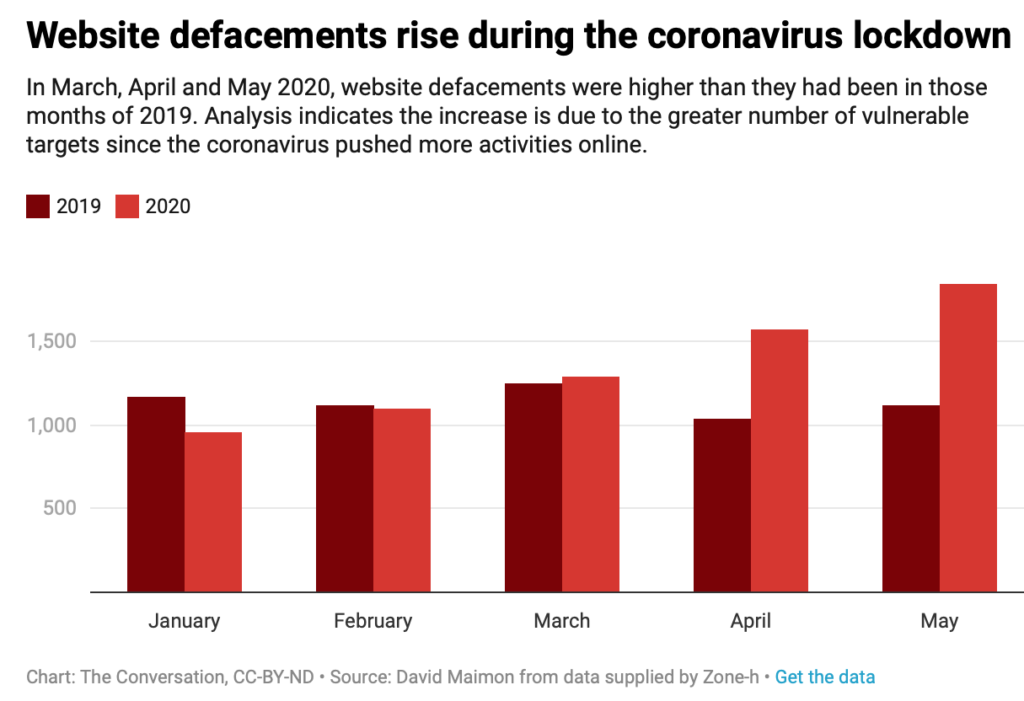 One consequence of the public’s compliance with social distancing and quarantines during the COVID-19 pandemic is a sharp decline in most types of crime. It looks like people staying home made communities less conducive to crime.
Unfortunately, the news isn’t as good as those numbers alone suggest. Other settings are seeing an increase in crime following the stay-at-home orders. One is the household, where domestic violence is likely to have increased in the past two months.
As researchers who study cybercrime, we’re finding that criminal activity seems to be on the rise in the online world, as well. At the same time, many people are relying more heavily than before on online services for work, entertainment and shopping. This makes them more likely to become the targets of different types of online crimes. And the websites and online platforms that these internet users access become more attractive targets to motivated hackers who aim to take them over and deface them.
One consequence of the public’s compliance with social distancing and quarantines during the COVID-19 pandemic is a sharp decline in most types of crime. It looks like people staying home made communities less conducive to crime.
Unfortunately, the news isn’t as good as those numbers alone suggest. Other settings are seeing an increase in crime following the stay-at-home orders. One is the household, where domestic violence is likely to have increased in the past two months.
As researchers who study cybercrime, we’re finding that criminal activity seems to be on the rise in the online world, as well. At the same time, many people are relying more heavily than before on online services for work, entertainment and shopping. This makes them more likely to become the targets of different types of online crimes. And the websites and online platforms that these internet users access become more attractive targets to motivated hackers who aim to take them over and deface them.
The coronavirus pandemic moved life online – a surge in website defacing followed
- Op-ed
 One consequence of the public’s compliance with social distancing and quarantines during the COVID-19 pandemic is a sharp decline in most types of crime. It looks like people staying home made communities less conducive to crime.
Unfortunately, the news isn’t as good as those numbers alone suggest. Other settings are seeing an increase in crime following the stay-at-home orders. One is the household, where domestic violence is likely to have increased in the past two months.
As researchers who study cybercrime, we’re finding that criminal activity seems to be on the rise in the online world, as well. At the same time, many people are relying more heavily than before on online services for work, entertainment and shopping. This makes them more likely to become the targets of different types of online crimes. And the websites and online platforms that these internet users access become more attractive targets to motivated hackers who aim to take them over and deface them.
One consequence of the public’s compliance with social distancing and quarantines during the COVID-19 pandemic is a sharp decline in most types of crime. It looks like people staying home made communities less conducive to crime.
Unfortunately, the news isn’t as good as those numbers alone suggest. Other settings are seeing an increase in crime following the stay-at-home orders. One is the household, where domestic violence is likely to have increased in the past two months.
As researchers who study cybercrime, we’re finding that criminal activity seems to be on the rise in the online world, as well. At the same time, many people are relying more heavily than before on online services for work, entertainment and shopping. This makes them more likely to become the targets of different types of online crimes. And the websites and online platforms that these internet users access become more attractive targets to motivated hackers who aim to take them over and deface them.
